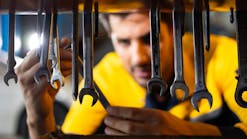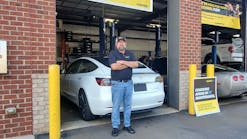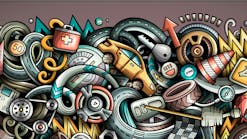As the repair industry faces supply chain constraints and lengthy waiting times for parts, many are looking for solutions to help overcome these obstacles, such as IBIS Global’s 3D Printing in Auto Repair Task Force.
The task force is dedicated to researching the application of 3D printing in the repair space and how it can be used in the production and repair of parts–not only by OEMs (Original Equipment Manufacturers) but in aftermarket segments as well.
Task force lead Harold Sears sat down with NOLN to talk about what he and his team have unearthed about this innovative technology and the ways it can be used to empower the repair industry.
The Beginning: Rapid Prototyping
Sears has worked with 3D printing for nearly 30 years, starting during his time at Ford Motor Company while helping them oversee the expansion of 3D printing technology in the company.
Sears was a CAD (computer-aided design) application programmer in the early 90s when his technology-inclined boss volunteered to take over the operations of a rapid prototyping machine installed in their building. The machine created 3D-printed parts for prototypes by adding material one layer at a time and was put there by the company’s product development group, who had no intention of running it after they finished experimenting with the machine.
The CAD models used as input for the processes of the machine were hard to come by at the time. With Sears’ intimate knowledge of CAD databases, his boss implemented his help to create solid models as input to the system, marking the beginning of Sears' involvement with 3D printing technology.
“My boss said, ‘Gosh, you know, you're helping so much with this group, do you want to become part of that group?’ And I said, ‘Yeah, I think so. I think it's (going to) be interesting for the future,’” Sears recalls. “Little did I know that 30 years ago, the decision that I made was going to impact the rest of my life.”
The Evolution into Additive Manufacturing
Between then and now, Sears has seen great developments in 3D printing technology. While it has initially been used for development application and prototyping under the name “rapid prototyping,” it has evolved into what is called additive manufacturing, which has utilized the capabilities of 3D printing to assist in optimizing design, reducing the weight of the parts, and reducing total part count.
Though companies such as Whirlpool and John Deere have implemented 3D printing in the repair of their products, the automotive industry has not been as willing to adopt the new tech. Much of this is a result of 3D printing materials not always being compatible with vehicles, with many of the processes for 3D printing utilizing UV-sensitive materials.
While UV-sensitive materials pose a risk for vehicles, there are still opportunities for parts that are located in places blocked from the sun, such as under a vehicle’s hood. Part of what Sears’ task force is doing is working with manufacturers to find out what parts of a vehicle could be 3D printed, and with what materials.
“Another goal of our task force in working with the automotive OEMs is (that) they're working hard at certifying these materials (and) they’re working hard at pushing the material suppliers to get these materials that they can certify and use in their applications,” Sears explains.
The Aftermarket Benefits of 3D Parts
As many OEMs become more interested in the use of 3D printing in production and work to make it happen, many opportunities are presented for those in the aftermarket industry as well to save time and money in obtaining and repairing parts.
Instead of tossing a part that has minor damage, with 3D printing shops could have the option to recreate small pieces of a part to help make it whole again. Not only will this save money and resources, but it also has a positive environmental effect.
“You may have a part that's perfectly good, and just a little piece is broken off of it that's not even visible to the customer, and it's totally repairable,” Sears says. “Why take that off and throw it in the garbage and have it end up in the landfill if you can 3D print that little piece and mend it back together and have the part be safe and functional for the customer?”
3D printing could also help with what Sears calls “captive inventories.” Oftentimes, shops are forced to order a minimum number of parts, even if it’s far more than what they need. This not only requires more money being spent but dedicated inventory space for all these extra parts.
If repair shops were able to 3D print a part on demand, it would eliminate the need for large inventories of parts sitting idle, which also contributes to driving up the cost of parts.
Though the technology is still a long way from reaching that point, Sears and his task force are helping both OEMs and providers of 3D printing materials to move towards this change.
“Things are starting to line up in that direction, where it may be possible in the future,” Sears says. “On-demand digital parts anywhere in the world, you know, with reduced turnaround times, and then, you know, less environmental impact from the technologies.”






